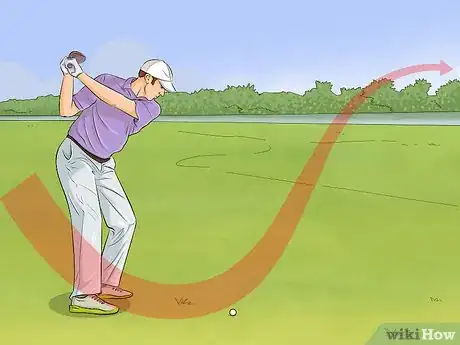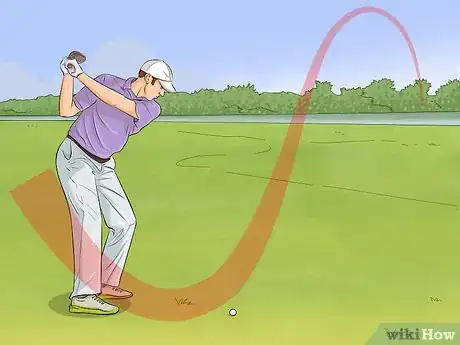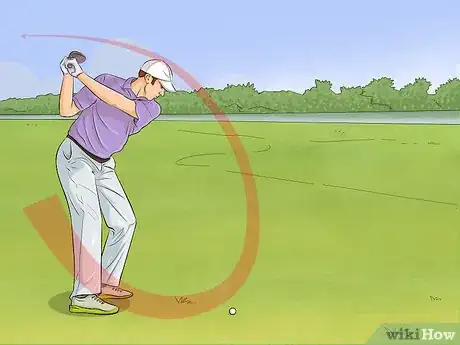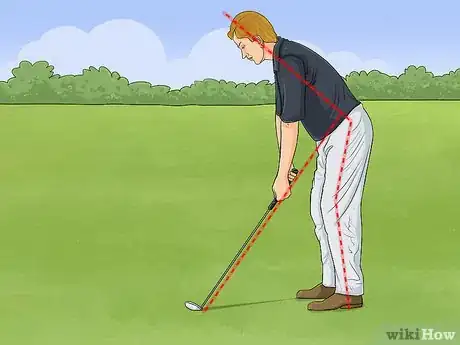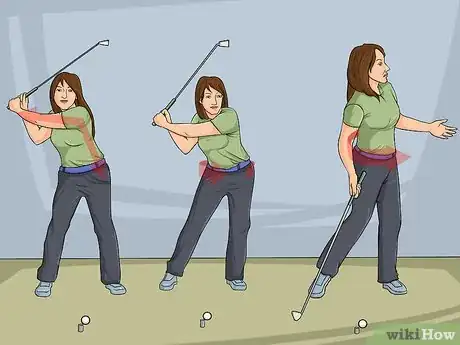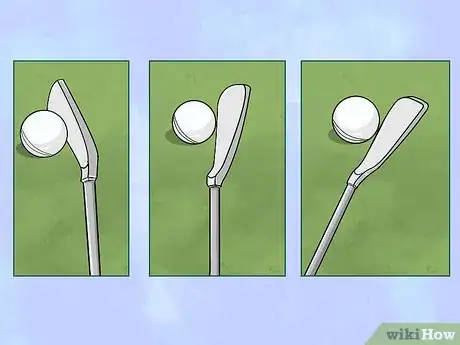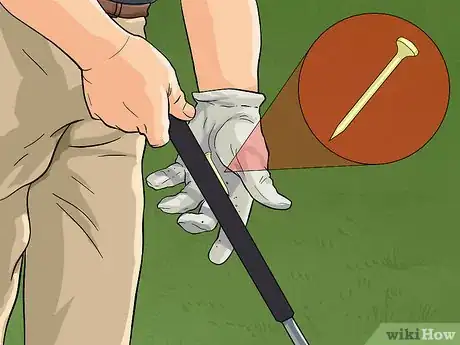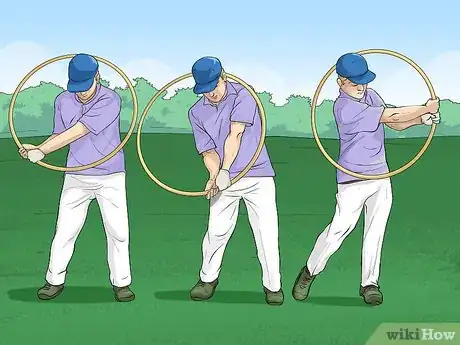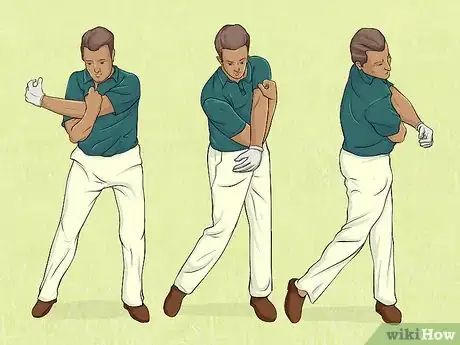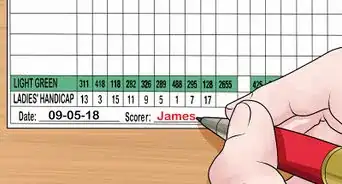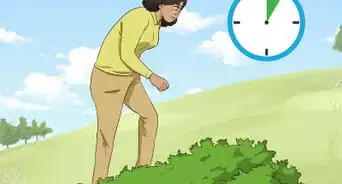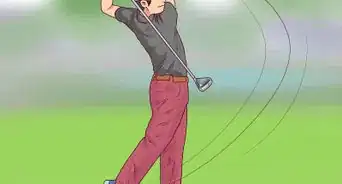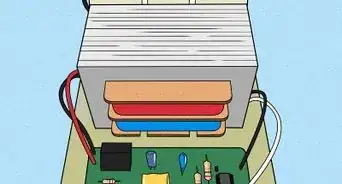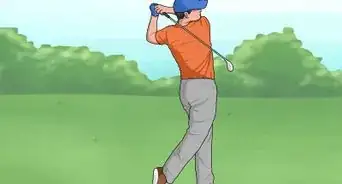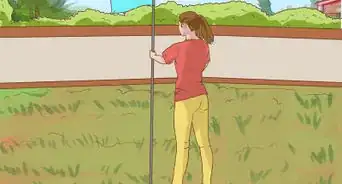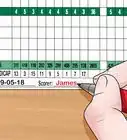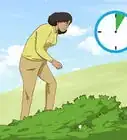This article was co-authored by Michael Metz. Michael Metz is a Golf Instructor and the Director of Instruction at Simi Hills Golf Course. With more than 15 years of experience, Michael is adept at coaching all facets of Golf. Mike uses technology, such as Flightscope, V1 Swing Suite, Blast Motion, and BodiTrak pressure mapping, to provide advanced golf training with quick results.
There are 8 references cited in this article, which can be found at the bottom of the page.
This article has been viewed 136,417 times.
A golf hook is a problem with a golfer's swing; however, a hook actually means that you’re well on your way to dependably hitting impressive shots.[1] Even good drivers can unintentionally develop a hook that needs correction.[2] Usually the cause of a hook is a strong grip that causes the club to swivel. You can correct a hook at home or out on the course by altering your grip, making the rotation of your body more active, and practicing with props.[3]
Steps
Diagnosing a Golf Hook
-
1Recognize a standard or push hook. If you’re right-handed, a push hook begins to the right of your target, but ends up curving back to the left. If you’re left-handed, a push hook starts to the left of the target, but curves back to the right.[4]
-
2Diagnose a straight hook. For right-handed golfers, a straight hook will start at the target but veer off to the left. If you’re left-handed, a straight hook will also start straight towards the target but will then curve to the right.[5]Advertisement
-
3
Practicing with a Golf Club
-
1Alter your grip. Put your right hand in a position that is more neutral.[8] You shouldn’t be able to see your left thumb. Adjust your right pointer finger under the handle in a “trigger” position to cradle the club.[9] Unless you have superb timing, letting your right palm leave the club during your swing will result in a snap-hook.[10]
- This step assumes the golfer is right-handed. Perform this with the opposite hand than instructed if you’re left-handed.
-
2Examine the path of your body with the club. You may be closing the club head too early. Instead of making a motion like you’re throwing the club head at the ball, you want to move your body with the club. Imagine there is a dagger at the top of your club that you are aiming at the ball in your downswing. This will help you to prevent uncocking your wrist too early.[11]
-
3Maintain your speed while rotating. Rather than focusing on trying to make a correction, focus on the movement of your body as a smooth motion. Carry the clubface through the swing without hesitation. You want your body to guide the club, so that you don’t overcompensate with movement of your wrists and hands.[12]
-
4Check the positioning of your clubface. A clubface is the side of the golf club’s head that hits the ball. Rotate the clubface open on the backswing as your arms and hips rotate. When the club is waist-high, the clubface should be toe-up. As you swing through, swing the clubface open to the left (or to the right if you’re left-handed).[13]
- An “open” clubface means that the toe of the club is too far back.
- Don’t approach the ball like a base that you’re sliding into, or you’ll end up trying to get underneath the ball rather than giving your swing stability. The clubface should remain square throughout the hit.[14]
Using Props
-
1Hold a golf tee in your grip. The palm of your right hand should apply continuous pressure to the thumb of your left hand. (If you’re left-handed, the palm of your left hand should apply pressure to the thumb of your right hand.) Try keeping a tee between those contact points as you swing the club.[15] Keep your right hand over your left hand on the grip during the downswing – or, if you’re left-handed, keep your left hand over your right hand.[16]
- This will help you become aware of the grip pressure you should maintain, so that you don’t change your grip during the swing and thereby hook the ball.
-
2Practice your swing at home using a hula hoop. Don’t use your golf club for this exercise; all you need is the hula hoop. Put the hula hoop over your body so that it is behind the back of your head and in front of your upper thighs. Hold the hula hoop as if you are holding a golf club, and rotate your body back and forth the way you would swing the club.[17]
- The motion of your swing will be held in check by the curvature of the hula hoop.
-
3Pin one arm to your chest. For this drill, your arm will act as your prop. Without using your golf club, pretend you are making a backswing. Hold your lead arm against your chest with your trail arm. Bend your trail arm like you’re curling a weight towards your heart, with your palm holding the upper part of your trail arm behind the elbow. Your lead arm should be pinned against your chest and your gloved hand does the swinging.[18]
- Practice swinging. Your motion should rotate your body as if you’re hitting the ball with the back of your gloved hand. This will give you the feeling of keeping your lead arm in sync with your body.
- If you’re right-handed, your lead arm is your left arm and your trail arm is the right arm. If you’re left-handed, it’s the opposite.
Expert Q&A
-
QuestionWhat is causing my golf hook?
 Michael MetzMichael Metz is a Golf Instructor and the Director of Instruction at Simi Hills Golf Course. With more than 15 years of experience, Michael is adept at coaching all facets of Golf. Mike uses technology, such as Flightscope, V1 Swing Suite, Blast Motion, and BodiTrak pressure mapping, to provide advanced golf training with quick results.
Michael MetzMichael Metz is a Golf Instructor and the Director of Instruction at Simi Hills Golf Course. With more than 15 years of experience, Michael is adept at coaching all facets of Golf. Mike uses technology, such as Flightscope, V1 Swing Suite, Blast Motion, and BodiTrak pressure mapping, to provide advanced golf training with quick results.
Golf Instructor Face at impact makes up 80% of the shape of a shot. So, at impact, if the ball starts straight and turns left, it’s typically because your path is too far in to out if you're a rightie — if the ball starts left and continues moving left, it’s because your face has to shut at impact.
Face at impact makes up 80% of the shape of a shot. So, at impact, if the ball starts straight and turns left, it’s typically because your path is too far in to out if you're a rightie — if the ball starts left and continues moving left, it’s because your face has to shut at impact.
References
- ↑ http://www.golfdigest.com/story/hank-haney-grip-fix
- ↑ http://www.golfchannel.com/media/golf-fix-eliminate-snap-hook/
- ↑ http://www.golfchannel.com/media/golf-fix-eliminate-snap-hook/
- ↑ http://golf-info-guide.com/golf-tips/golf-drills/hook-golf-shot-drills-introduction/
- ↑ http://golf-info-guide.com/golf-tips/golf-drills/hook-golf-shot-drills-introduction/
- ↑ http://golf-info-guide.com/golf-tips/golf-drills/hook-golf-shot-drills-introduction/
- ↑ http://golf-info-guide.com/golf-tips/playing-conditions/causes-and-cures-pull-hooks
- ↑ Michael Metz. Golf Instructor. Expert Interview. 24 February 2022.
- ↑ http://www.golfdigest.com/story/hank-haney-grip-fix
- ↑ http://www.golf.com/instruction/how-lose-your-snap-hook-5-minutes
- ↑ http://www.golfchannel.com/media/school-golf-fixing-your-hook/
- ↑ http://www.golfchannel.com/media/golf-fix-eliminate-snap-hook/
- ↑ http://www.golf.com/video/instant-fix-stop-your-hook-now
- ↑ http://www.golfchannel.com/media/golf-fix-eliminate-snap-hook/
- ↑ http://www.golfchannel.com/media/school-golf-fixing-your-hook/
- ↑ http://www.golf.com/instruction/how-lose-your-snap-hook-5-minutes
- ↑ http://www.golfchannel.com/media/school-golf-fixing-your-hook/
- ↑ http://www.golfchannel.com/media/golf-fix-eliminate-snap-hook/
About This Article
To fix a golf hook, try altering the way you grip your club. Put your right hand in a neutral position, with your right index finger under the handle in a trigger position. You should not be able to see your left thumb. As you swing, maintain your speed, and carry the clubface through the swing without hesitation. Don’t use your wrists and hands to adjust during your swing, as this is often what causes the ball to hook. Keep reading to learn how holding a golf tee in your grip can help fix a hook!
